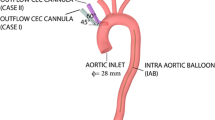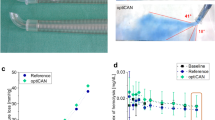Abstract
Cardiopulmonary bypass is a well-established technique during open heart surgeries. However, neurological complications due to insufficient cerebral oxygen supply occur and the severe consequences must not be neglected. Recent computational fluid dynamics (CFD) studies showed that during axillary cannulation the cerebral perfusion is strongly affected by the distance between the cannula tip and the vertebral artery branch. In this study we use two modifications of the cannula design to analyze the flow characteristics by means of CFD and experimental validation with particle image velocimetry (PIV). One approach applies a spin to the blood stream with a helical surface in the cannula cross section. Another approach uses radial bores in a constricted cannula tip to split the outflow jet. The additional helicity improves the perfusion of the cerebral vessels and suppresses the blood suction in the right vertebral artery observed with a standard cannula. The cannula with a helix throughout the entire length changes the blood flow from −124 to 32 mL/min in comparison with an unmodified design and has the lowest prediction of blood damage. Separating the blood stream does not deliver satisfying results. The PIV measurements validate the simulations and correspond with the velocity distribution as well as vortex locations.








Similar content being viewed by others
References
Ballyk, P. D., D. A. Steinman, and C. R. Ethier. Simulation of non-Newtonian blood flow in an end-to-end anastomosis. Biorheology 31(5):565–586, 1994.
Bludszuweit, C. Three-dimensional numerical prediction of stress loading of blood particles in a centrifugal pump. Artif. Organs 19(7):590–596, 1995.
Brodman, R., H. Siegel, M. Lesser, and A. Frater. A comparison of flow gradients across disposable perfusion cannulae. Ann. Thorac. Surg. 39:225–233, 1985.
Caro, C., and D. Doorly. Modified cannula US5997516A—USA, 12 7, 1999.
Fukuda, I., S. Osanai, M. Shirota, T. Inamura, H. Yanaoka, M. Minakawa, and K. Fukui. Computer-simulated fluid dynamics of arterial perfusion in extracorporeal circulation: from reality to virtual simulation. Int. J. Artif. Org. 32(6):362–370, 2009.
Gerdes, A., T. H. Hanke, and H. H. Sievers. Hydrodynamics of new medos aortic cannula. Perfusion 17(3):217–220, 2002.
Gerdes, A., E. Joubert-Huebner, K. Esders, and H. H. Sievers. Hydrodynamics of aortic arch vessels during perfusion through the right subclavian artery. Ann. Throc. Surg. 69(5):1425–1430, 2000.
Ji, B., and A. Undar. An evaluation of the benefits of pulsatile vs. nonpulsatile perfusion during cardiopulmonary bypass procedures in pediatric and adult cardiac patients. ASAIO J. 52(4):357–361, 2006.
Kapetanakis, E. I., S. C. Stamou, M. K. Dullum, P. C. Hill, E. Halle, S. W. Boyce, A. S. Bafi, K. R. Petro, and P. J. Corso. The impact of aortic manipulation on neurologic outcomes after coronary artery bypass surgery: a risk-adjusted study. Ann. Thorac. Surg. 78(5):1564–1571, 2004.
Kaufmann, T. A., M. Hormes, L. Laumen, D. L. Timms, T. Linde, T. Schmitz-Rode, A. Moritz, O. Dzemali, and U. Steinseifer. Flow distribution during cardiopulmonary bypass in dependency on the outflow cannula positioning. Artif. Organs. 33(11):988–992, 2009.
Kaufmann, T. A., M. Hormes, L. Laumen, D. L. Timms, T. Linde, T. Schmitz-Rode, A. Moritz, O. Dzemali, and U. Steinseifer. The impact of aortic/subclavian outflow cannulation for cardiopulmonary bypass and cardiac support: a computational fluid dynamics study. Artif. Organs 33(9):727–732, 2009.
Kaufmann, T. A., M. Neidlin, M. Büsen, S. J. Sonntag, and U. Steinseifer. Implementation of intrinsic lumped parameter modeling into computational fluid dynamics studies of cardiopulmonary bypass. J. Biomech. 47(3):729–735, 2014.
Kaufmann, T. A., T. Schmitz-Rode, and U. Steinseifer. Implementation of cerebral autoregulation into computational fluid dynamics studies of cardiopulmonary bypass. Artif. Organs 36(8):754–758, 2012.
Laumen, M., T. A. Kaufmann, D. L. Timms, P. Schlanstein, S. Jansen, S. Gregory, K. Wong, T. Schmitz-Rode, and U. Steinseifer. Flow analysis of ventricular assist device inflow and outflow cannula positioning using a naturally shaped ventricle and aortic branch. Artif. Organs 34(19):798–806, 2010.
Menon, P. G., J. F. Antaki, A. Undar, and K. Pekkan. Aortic outflow cannula tip design and orientation impacts cerebral perfusion during pediatric cardiopulmonary bypass procedures. Ann. Biomed. Eng. 41:2588–2602, 2013.
Paulson, O. B., S. Strandgaard, and L. Edvinsson. Cerebral autoregulation. Cerebrovasc. Brain Metab. Rev. 2:161–192, 1990.
Saunders Soft-Flow aortic cannula tip US2006/0253059A1—USA, 11 09, 2006.
Scarborough, J. E., W. White, F. E. Derilus, J. P. Mathew, M. F. Newman, and K. P. Landolfo. Neurological outcomes after coronary artery bypass grafting with and without cardiopulmonary bypass. Semin. Thorac. Cardiovasc. Surg. 15(1):52–62, 2003.
Schell, R. M., F. H. Kern, W. J. Greeley, S. R. Schulman, P. E. Frasco, N. D. Croughwell, M. Newman, and J. G. Reves. Cerebral blood flow and metabolism during cardiopulmonary bypass. Anesth. Analg. 76(4):849–865, 1993.
Taskin, M. E., K. H. Fraser, T. Zhang, C. Wu, B. P. Griffith, and Z. J. Wu. Evaluation of Eulerian and Lagrangian models for hemolysis estimation. ASAIO J. 58(4):363–372, 2012.
Tokuda, Y., M. H. Song, Y. Ueda, A. Usui, T. Akita, S. Yoneyama, and S. Maruyama. Three-dimensional numerical simulation of blood flow in the aortic arch during cardiopulmonary bypass. Eur. J. Cardiothorac. Surg. 33(2):164–167, 2008.
Undar, A., T. Masai, O. H. Frazier, and C. D. Fraser, Jr. Pulsatile and nonpulsatile flows can be quantified in terms of energy equivalent pressure during cardiopulmonary bypass for direct comparisons. ASAIO J. 45(6):610–614, 1999.
Zhang, T., M. E. Taskin, and H. B. Fang. Study of flow-induced hemolysis using novel Couette-type blood shearing devices. Artif. Organs 35:1071–1085, 2011.
Author information
Authors and Affiliations
Corresponding author
Additional information
Associate Editor Peter E. McHugh oversaw the review of this article.
Electronic supplementary material
Below is the link to the electronic supplementary material.
Rights and permissions
About this article
Cite this article
Neidlin, M., Jansen, S., Moritz, A. et al. Design Modifications and Computational Fluid Dynamic Analysis of an Outflow Cannula for Cardiopulmonary Bypass. Ann Biomed Eng 42, 2048–2057 (2014). https://doi.org/10.1007/s10439-014-1064-y
Received:
Accepted:
Published:
Issue Date:
DOI: https://doi.org/10.1007/s10439-014-1064-y




